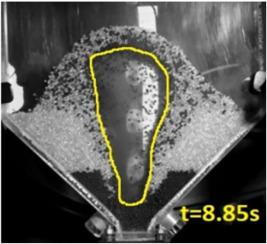颗粒表面改性对矩形喷床喷射开始的影响
IF 4.3
2区 材料科学
Q2 ENGINEERING, CHEMICAL
引用次数: 0
摘要
在矩形喷流床上进行了实验,研究了颗粒表面改性对气固流体力学的影响。用丙烯酸涂料对颗粒进行表面改性。当使用包覆颗粒时,在喷射开始时观察到完全不同的固体流动模式。来自床顶的颗粒以特定的气体流速流化,裂缝向下扩展,而不是在气体入口喷嘴处形成空腔。在此之后,底部形成一个大气泡,随后随着压力的释放而破裂。我们首次报道了这种迄今为止未知的浅颗粒层现象。用高速成像技术表征了瞬时粒子动力学。推导出包覆颗粒的内聚性是这种异常喷淋行为的控制参数。在相同的静态床层高度下,涂层玻璃微珠的峰值压降和相应的表面气速比未涂层玻璃微珠更显著。当包覆颗粒的体积分数大于20%时,未包覆和包覆玻璃珠的均匀混合物表现出与纯包覆颗粒相同的床层特性。本文章由计算机程序翻译,如有差异,请以英文原文为准。

Effect of particle surface modification on the onset of spouting in a rectangular spouted bed
Experiments were conducted in a rectangular spouted bed to study the effect of surface modification of the particles on the gas-solid hydrodynamics. The surface was modified by doing coating the particles with acrylic paint. A completely different solid flow pattern was observed at the onset of spouting when coated particles were used. Instead of forming a cavity at the gas entry nozzle, particles from the top of the bed were fluidized at a particular gas flow rate, and a crack propagated downwards. After that, a big gas bubble formed at the bottom, which subsequently underwent bursting with the release of pressure. We report such hitherto unknown phenomena for a shallow granular bed for the first time. Instantaneous particle dynamics have been characterized using high-speed imaging. It is deduced that the cohesiveness of coated particles is the controlling parameter for this anomalous spouting behavior. Peak pressure drop and the corresponding superficial gas velocity for coated glass beads are more significant than uncoated particles for the same static bed height. A homogenous mixture of uncoated and coated glass beads exhibited bed characteristics as that of pure coated particles if the volume fraction of coated particles is greater than 20 %.
求助全文
通过发布文献求助,成功后即可免费获取论文全文。
去求助
来源期刊

Particuology
工程技术-材料科学:综合
CiteScore
6.70
自引率
2.90%
发文量
1730
审稿时长
32 days
期刊介绍:
The word ‘particuology’ was coined to parallel the discipline for the science and technology of particles.
Particuology is an interdisciplinary journal that publishes frontier research articles and critical reviews on the discovery, formulation and engineering of particulate materials, processes and systems. It especially welcomes contributions utilising advanced theoretical, modelling and measurement methods to enable the discovery and creation of new particulate materials, and the manufacturing of functional particulate-based products, such as sensors.
Papers are handled by Thematic Editors who oversee contributions from specific subject fields. These fields are classified into: Particle Synthesis and Modification; Particle Characterization and Measurement; Granular Systems and Bulk Solids Technology; Fluidization and Particle-Fluid Systems; Aerosols; and Applications of Particle Technology.
Key topics concerning the creation and processing of particulates include:
-Modelling and simulation of particle formation, collective behaviour of particles and systems for particle production over a broad spectrum of length scales
-Mining of experimental data for particle synthesis and surface properties to facilitate the creation of new materials and processes
-Particle design and preparation including controlled response and sensing functionalities in formation, delivery systems and biological systems, etc.
-Experimental and computational methods for visualization and analysis of particulate system.
These topics are broadly relevant to the production of materials, pharmaceuticals and food, and to the conversion of energy resources to fuels and protection of the environment.
 求助内容:
求助内容: 应助结果提醒方式:
应助结果提醒方式:


